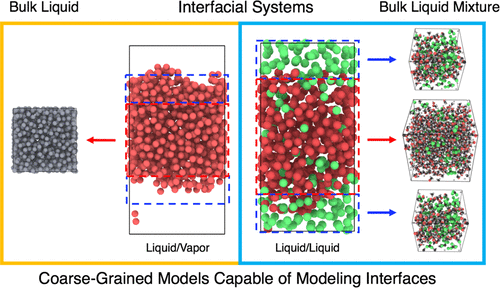当前位置:
X-MOL 学术
›
J. Chem. Theory Comput.
›
论文详情
Our official English website, www.x-mol.net, welcomes your feedback! (Note: you will need to create a separate account there.)
Ultra-Coarse-Grained Models Allow for an Accurate and Transferable Treatment of Interfacial Systems
Journal of Chemical Theory and Computation ( IF 5.5 ) Pub Date : 2018-02-26 00:00:00 , DOI: 10.1021/acs.jctc.7b01173 Jaehyeok Jin 1 , Gregory A. Voth 1
Journal of Chemical Theory and Computation ( IF 5.5 ) Pub Date : 2018-02-26 00:00:00 , DOI: 10.1021/acs.jctc.7b01173 Jaehyeok Jin 1 , Gregory A. Voth 1
Affiliation

|
Interfacial systems are fundamentally important in many processes. However, constructing coarse-grained (CG) models for such systems is a significant challenge due to their inhomogeneous nature. This problem is made worse due to the generally nontransferable nature of the interactions in CG models across different phases. In this paper, we address these challenges by systematically constructing ultra-coarse-grained (UCG) models for interfaces, in which the CG sites are allowed to have internal states. We find that a multiscale coarse-grained (MS-CG) representation of a single CG site model fails to identify the directionality of a molecule and is unable to reproduce the correct phase coexistence for aspherical molecules. In contrast with conventional MS-CG models, the UCG methodology allows chemical and environmental changes to be captured by modulating the interactions between internal states. In this work, we design the internal states to depend on local particle density to distinguish different phases in liquid/vapor or liquid/liquid interfaces. These UCG models are able to capture phase coexistence and recapitulate structures, notably at state points in which the MS-CG method yields poor results. Interestingly, effective pairwise forces and potentials from the UCG models are almost identical to those of the bulk liquids that correspond to each phase, indicating that the UCG approach can provide transferable interactions. This approach is expected to be applicable to other systems that exhibit phase coexistence and also to complex macromolecular systems by modulating interactions based on local density or other order parameters to unravel the complex nature underlying heterogeneous system boundaries.
中文翻译:

超粗粒模型允许对界面系统进行准确且可转移的处理
界面系统在许多过程中都至关重要。然而,由于其系统的不均匀性,为此类系统构建粗粒度(CG)模型是一项重大挑战。由于CG模型在不同阶段之间的交互通常具有不可转移的性质,因此此问题变得更加严重。在本文中,我们通过系统地构建接口的超粗粒度(UCG)模型来解决这些挑战,在该模型中,允许CG站点具有内部状态。我们发现单个CG站点模型的多尺度粗粒度(MS-CG)表示无法识别分子的方向性,并且无法再现非球面分子的正确相共存。与传统的MS-CG模型相比,UCG方法允许通过调节内部状态之间的相互作用来捕获化学和环境变化。在这项工作中,我们将内部状态设计为依赖于局部粒子密度,以区分液体/蒸气或液体/液体界面中的不同相。这些UCG模型能够捕获相共存并重现结构,特别是在MS-CG方法产生较差结果的状态点。有趣的是,来自UCG模型的有效成对力和势几乎与对应于每个相的散装液体的成对力和势相同,这表明UCG方法可以提供可传递的相互作用。
更新日期:2018-02-26
中文翻译:

超粗粒模型允许对界面系统进行准确且可转移的处理
界面系统在许多过程中都至关重要。然而,由于其系统的不均匀性,为此类系统构建粗粒度(CG)模型是一项重大挑战。由于CG模型在不同阶段之间的交互通常具有不可转移的性质,因此此问题变得更加严重。在本文中,我们通过系统地构建接口的超粗粒度(UCG)模型来解决这些挑战,在该模型中,允许CG站点具有内部状态。我们发现单个CG站点模型的多尺度粗粒度(MS-CG)表示无法识别分子的方向性,并且无法再现非球面分子的正确相共存。与传统的MS-CG模型相比,UCG方法允许通过调节内部状态之间的相互作用来捕获化学和环境变化。在这项工作中,我们将内部状态设计为依赖于局部粒子密度,以区分液体/蒸气或液体/液体界面中的不同相。这些UCG模型能够捕获相共存并重现结构,特别是在MS-CG方法产生较差结果的状态点。有趣的是,来自UCG模型的有效成对力和势几乎与对应于每个相的散装液体的成对力和势相同,这表明UCG方法可以提供可传递的相互作用。



























 京公网安备 11010802027423号
京公网安备 11010802027423号